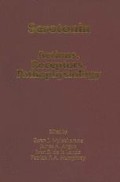Abstract
The presence of 5-HT3 receptor-mediated responses in peripheral tissues is well established. Their presence in the CNS is implied by the powerful behavioural effects produced by 5-HT3 receptor antagonists in laboratory animals (Costall et al., 1987a, b; Jones et al., 1987, 1988; Tyers et al., 1987). However, despite the high selectivity of action of these compounds for the 5-HT3 receptor, there is no direct evidence that 5-HT3 receptors are present in the brain. Three series of experiments have been conducted to address this issue: functional studies on central 5-HT pathways; effects on mesolimbic dopamine metabolism; and binding studies with a novel [3H]-labelled 5-HT3 receptor antagonist.
Access this chapter
Tax calculation will be finalised at checkout
Purchases are for personal use only
Preview
Unable to display preview. Download preview PDF.
References
Butler, A., Hill, J. M., Ireland, S. J. and Tyers, M. B. (1988). Pharmacological properties of GR 38032F, a novel antagonist at 5-HT3 receptors. Br. J. Pharmacol., 94, 397–412.
Costall, B., Domeney, A. M., Kelly, M. E., Naylor, R. J. and Tyers, M. B. (1987a). The antipsychotic potential of GR 38032F, a selective antagonist of 5-HT3receptors in the central nervous system. Br. J. Pharmacol., 90, 89P
Costall, B., Domeney, A. M., Naylor, R. J. and Tyers, M. B. (1987b). Effects of the 5-HT3 receptor antagonist, GR 38032F, on raised dopaminergic activity in the mesolimbic system of the rat and marmoset brain. Br. J. Pharmacol., 92, 881–894
Costall, B., Hendrie, C. A., Kelly, M. E. and Naylor, R. J. (1987c). Actions of sulpiride and tiapride in a simple model of anxiety in mice. Neuropharmacology, 26, 195–200
Elliott, P., Alpert, J. E., Bannon, M. J. and Iversen, S. D. (1986). Selective activation of mesolimbic and mesocortical dopamine metabolism in rat brain by infusion of a stable substance P analogue into the ventral tegmental area. Brain Res., 363, 145–147
Fake, C. S., King, F. D. and Sanger, G. J. (1987). BRL 43694: a potent and novel 5-HT3 receptor antagonist. Br. J. Pharmacol., 91, 335P
Fozard, J. R. (1984). MDL 72222: a potent and highly selective antagonist at neuronal 5-hydroxytryptamine receptors. Naunyn-Schmiedeberg’s Arch. Pharmacol., 326, 36–44
Hagan, R. M., Butler, A., Hill, J. M., Jordan, C. C., Ireland, S. J. and Tyers, M. B. (1987). Effect of the 5-HT3 receptor antagonist GR 38032F, on responses to injection of a neurokinin agonist into the ventral tegmental area of the rat brain. Eur. J. Pharmacol., 138, 303–305
Ireland, S. J. and Tyers, M. B. (1987). Pharmacological characterisation of 5-hydroxytryptamine-induced depolarisation of the rat isolated vagus nerve. Br. J. Pharmacol., 90, 229–238
Jones, B. J., Oakley, N. R. and Tyers, M. B. (1987). The anxiolytic activity of GR 38032F, a 5-HT3 receptor antagonist, in the rat and Cynomolgus monkey. Br. J. Pharmacol., 90, 88P
Jones, B. J., Costall, B., Domeney, A. M., Kelly, M. E., Naylor, R. J., Oakley, N. R. and Tyers, M. B. (1988). The potential anxiolytic activity of GR 38032F, a 5-HT3 receptor antagonist. Br. J. Pharmacol., 93, 985–993
Kilpatrick, G. J., Jones, B. J. and Tyers, M. B. (1987). Identification and distribution of 5-HT3 receptors in rat brain using radioligand binding. Nature, 330, 746–748
Peroutka, S. J. and Snyder, S. H. (1979). Multiple serotonin receptors: differential binding of [3H]-5-hydroxytryptamine, [3H]-lysergic acid diethylamide and [3H]-spiroperidol. Mol. Pharmacol., 16, 687–699
Peroutka, S. J., Lebovitz, R. M. and Snyder, S. H. (1981). Two distinct central serotonin receptors with different physiological functions. Science, 212, 827–829
Richardson, B. P., Engel, G., Donatsch, P. and Stadler, P. A. (1985). Identification of serotonin M-receptor subtypes and their specific blockade by a new class of drugs. Nature, 316, 126–131
Tyers, M. B., Costall, B., Domeney, A. M., Jones, B. J., Kelly, M. E., Naylor, R. J. and Oakley, N. R. (1987). The anxiolytic activities of 5-HT3 antagonists in laboratory animals. Neurosci. Lett., Suppl. 29, S68
Author information
Authors and Affiliations
Editor information
Editors and Affiliations
Copyright information
© 1989 The editors and contributors
About this chapter
Cite this chapter
Tyers, M.B., Costall, B., Naylor, R.J. (1989). 5-HT3 Receptors in the Central Nervous System. In: Mylecharane, E.J., Angus, J.A., de la Lande, I.S., Humphrey, P.P.A. (eds) Serotonin. Satellite Symposia of the IUPHAR 10th International Congress of Pharmacology. Palgrave Macmillan, London. https://doi.org/10.1007/978-1-349-10114-6_12
Download citation
DOI: https://doi.org/10.1007/978-1-349-10114-6_12
Publisher Name: Palgrave Macmillan, London
Print ISBN: 978-1-349-10116-0
Online ISBN: 978-1-349-10114-6
eBook Packages: Biomedical and Life SciencesBiomedical and Life Sciences (R0)

